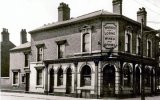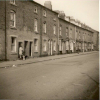-
Welcome to this forum . We are a worldwide group with a common interest in Birmingham and its history. While here, please follow a few simple rules. We ask that you respect other members, thank those who have helped you and please keep your contributions on-topic with the thread.
We do hope you enjoy your visit. BHF Admin Team
You are using an out of date browser. It may not display this or other websites correctly.
You should upgrade or use an alternative browser.
You should upgrade or use an alternative browser.
Arsenal Street
- Thread starter FauxFaux
- Start date
-
- Tags
- arsenal street aston
MWS
from Bham
Not always straightforward to work out what the houses were like in the past. Below is a map from 1889 (arrow I think points to no. 32) and the houses look quite large. Possibly only one back to back and the houses mostly appear to have gardens. Occupations are another thing to look at in 1891 there were a wide range - including bricklayers and stonemasons, clerks and a solicitor. So I would say they were quite good for the time.


An older photo of The Marquis of LorneHere are a couple of photographs. The first is "The Marquis of Lorne", the second is Greenway Street, which is off Arsenal Street, so it may give some idea of what the properties in Arsenal Street, may have looked like (I wasn't able to find any old photographs of the housing in Arsenal Street):
View attachment 191537
View attachment 191538

brummy-lad
master brummie
Thank you everyone, this is all so, so helpful. This particular ancestor was a carpenter from Shropshire and they've been critical in my research. Only recently found out where he was when he died and it completes the puzzle of his life. As with so many Victorian Brummies sadly you find that they are buried in common graves with no headstone to remember them and every house they ever lived in has been torn down to make way for new estates and warehouses... Another reason why the work of the community here is so important for keeping working class Brum history alive as there are still people who remember these buildings as they were before these big changes took place.
totally agree with you...well said and it is also the aim of this forum to do the same...we hold a wealth of informationThank you everyone, this is all so, so helpful. This particular ancestor was a carpenter from Shropshire and they've been critical in my research. Only recently found out where he was when he died and it completes the puzzle of his life. As with so many Victorian Brummies sadly you find that they are buried in common graves with no headstone to remember them and every house they ever lived in has been torn down to make way for new estates and warehouses... Another reason why the work of the community here is so important for keeping working class Brum history alive as there are still people who remember these buildings as they were before these big changes took place.
lyn




